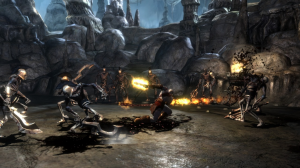The discussions on why there aren’t more diverse characters and stories in video games got me thinking about what I feel is one of the main issues that is in the way and that has to do with the writers themselves. Projecting ourselves into our works is a basic step in developing a narrative and one area that’s going to take a lot of work if we’re going to see any improvement. And today I take a pessimistic/realistic view of what needs to change.
Self Projection:
One of the basic ways of how to start writing a story is to put yourself in the story. How would you handle this situation, deal with the crisis or save the world? This is where projecting comes into play: Either as putting yourself or an idealized version as the hero or creating a world or fantasy that you would like to experience.
The reason is that if you are trying to write a story and you need to base it off of something, who better to use as a foundation than your personal experience or fantasies? I remember an interview that the creator of God of War, David Jaffe did before the game came out. He said that the character of Kratos despite not looking anything like him was a projection of his wild side, his anger, that bad ass take charge kind of person that he fantasizes about being.
And this is one of the main reasons for the lack of diversity among game narratives as we write about what we know and what the majority of designers know about is being a straight white male. Another part of this is that it is safe and avoids any kind of misrepresentation that neither the publisher nor the developer wants.
Let’s say someone wants to make a serious story with an African American lead, but their only knowledge about African American characters is from the Blaxploitation movies of the 70s. It won’t take much to imagine the backlash from the African American community.
Now it’s important to mention that while it is hard to write well rounded characters outside of your comfort zone/experience, it’s not impossible.
One of the best female characters I saw in a video game was from the Blackwell series written by Dave Gilbert who is obviously not a woman. And that brings up another important point: While it is harder to write characters outside of your comfort zone, you should not dismiss or praise a work solely from the gender/background of the person writing it.
One common criticism I hear on message boards is that you should only be allowed to write characters based on your background — So a white man should only write white male characters, a woman should only write female characters etc. This is completely wrong in my opinion and as long as the writer has respect for the source material and wants to tell a meaningful story, then the color of their skin or their gender should have no effect on that.
Now getting out of your comfort zone sounds like a tough task to begin with, but there is still one other major area that is going to prove herculean to get around.
Finding the Fans:
You can point out that diverse characters would make more sales, that women now make up 48% of the audience playing video games and that adhering to tropes and stereotypes don’t make for great stories. But there is one group that has control over what games are being sold to the general consumer. And they care about some other facts and are the people in charge of game publishing.
They care that games like Call of Duty and Madden are making millions and millions of dollars in sales. And that this demographic will also buy DLC and Xbox Live subscriptions and can be easily sold products like Mountain Dew and Doritos as long as Master Chief or Call of Duty is on the cover. This demographic is the 18-30 male and it’s one that publishers have their sights on.
It’s a group with a lot of disposable cash that is a prime target for advertisers due to how easy it is to market to them.
This is why we see triple AAA commercials and advertisements go for the same marketing plans of explosions, hot women and random rap songs to get them pumped for the game. This is also why Bioshock Infinite’s cover featured Booker on it as opposed to Elizabeth and why multiplayer and first person shooters have become the popular genre for AAA games as that’s what this demographic likes to play.
You don’t need to spend time on complex stories, unique gameplay or diverse characters when you know that there is an audience out there who will buy your game about a bad ass white guy shooting other bad ass white guys for either revenge or to save the world as long as there is online multiplayer… with an optional hot female character as a love interest.
Breaking the Trend:
As we’ve talked about in the past, AAA development is incredibility risk adverse and don’t want to take a chance on a game that “might” sell when they can make something that they know will sell. And with the 18-30 male demographic so lucrative, they want people to write stories that appeal to them. And with how easy it is to project yourself, it makes white straight male writers popular among the AAA as they line up perfectly with the target demographic.

Despite featuring a strong female character and getting rave reviews, it took Tomb Raider a long time for Square Enix to consider it profitable.
Now here’s the big question: What can we do to change that? It’s not going to be an easy road as there is a catch 22 situation at work. To have more diverse characters in AAA games, we need to see a game with a female character sell just as well as a Call of Duty or Madden.
But to do that we need to convince publishers to make a game featuring a well defined female character (with great gameplay to boot) which they won’t do because there aren’t games being made with female characters and it’s too risky to be the first one.
And before anyone points out that Tomb Raider did incredibility well, it’s important to remember that for the longest time Square Enix cited the game as a failure for not moving enough copies. What the publisher wants is to see something getting Call of Duty profits on day or week one.
If we’re going to see more diverse characters in the Game Industry, then it will have to come from the Indie market. In this case, instead of tricking down from the AAA, we need to show AAA publishers that the market is there for games with diverse characters and richer narratives and hopefully that will rise up so that the big wigs will see it.
I really hate to say this next line as it has been used by so many as an attack on games for women and women in the industry. But we really, really need to get more women interested in game development so that they can create/write for games. This isn’t saying that women need to “put up or shut up” but that in order to get diverse stories we need a diverse pool of writers and designers.

Great female characters have been seen in the Indie market which is where I feel the change needs to come from.
With the rise of the Indie market and the freedom that comes from it, now is perhaps the best time to move forward.
We are at a point in the Game Industry where people are now questioning the tropes and preconceived notions of both society and Game Design. And technology has advanced to the point where a group of people can easily make a game without needing millions of dollars for development costs.
With publishers listening to their checkbooks, if we can get games that don’t rely on the straight white male to become big successes, then maybe we can convince them to change their minds. Otherwise just yelling and screaming is not going to be enough. As no matter how loud we yell, the sounds of gunfire, explosions and money will be louder.




